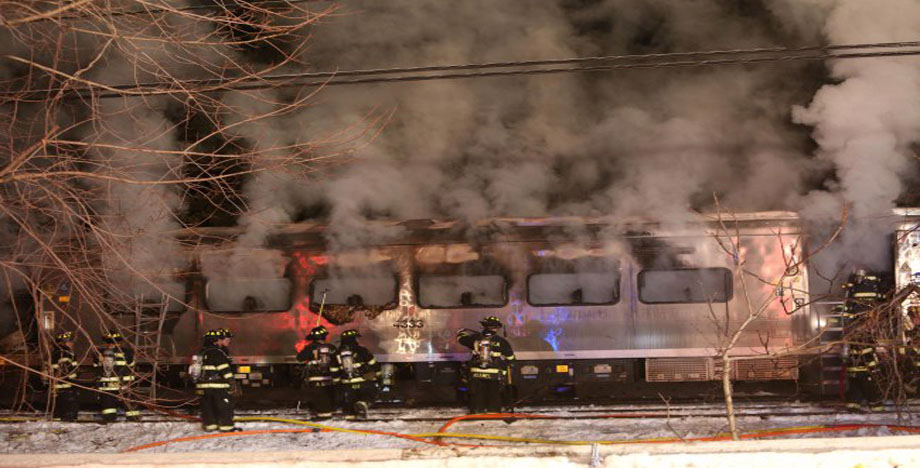
Investigators headed Wednesday to the site of a fiery commuter train crash that killed six people, seeking clues to why the SUV that triggered the wreck was stopped on the tracks.
As a National Transportation Safety Board team headed from Washington to the crash site, local officials worked to identify those killed in the deadliest accident on one of the nation’s busiest commuter rail lines — one that has come under harsh scrutiny over safety after a series of accidents in recent years. Fifteen people remained hospitalized as officials said they were, for now, mystified by the ghastly crash on the Metro-North Railroad.
“It’s really inexplicable, based on the facts we have now,” Gov. Andrew Cuomo said on WCBS-AM radio. “Everybody wants to know exactly what happened, so that if something can be corrected, we correct it.”
Five train passengers — authorities initially said six — and the SUV’s driver were killed in Tuesday evening’s crash, in Valhalla, about 20 miles north of New York City. Authorities said the impact was so forceful the electrified third rail came up and pierced the train.
Westchester County Executive Rob Astorino said the front part of the train was “completely charred and burned.”
“I am amazed anyone got off that train alive. … It must have been pure panic, with the flames, the third rail and the smoke,” he said.
Authorities said the SUV’s driver had gotten out of her vehicle momentarily after the crossing’s safety gates came down around her. She then got back in and was trying to drive forward when she was hit, they said.
The northbound Metro-North Railroad train left Grand Central Terminal in Manhattan around 5:45 p.m. and struck the SUV about 45 minutes later.
It was unclear how fast the train was going, but the maximum would be 60 mph, a railroad official said.
The train shoved the SUV about 10 train car lengths. Smoke poured out of the scorched front rail car, its windows blackened.
“This is a truly ugly and brutal sight,” said Cuomo, who called the crash the railroad’s most deadly.
Witnesses said they saw the flames shooting from where the crash occurred, in a wooded area near a cemetery.
Ryan Cottrell, assistant director at a nearby rock climbing gym, said he had been looking out a window because of an earlier, unrelated car accident and saw the train hit the car, pushing it along.
“The flames erupted pretty quickly,” he said.
Passengers described a bump and said they smelled gasoline from the vehicle.
Around 650 passengers likely were aboard the train, including Justin Kaback, commuting home to Danbury, Connecticut.
“I was trapped. You know there was people in front of me and behind me, and I was trapped in the middle of a car and it was getting very hot,” he told ABC News. “All the air was turned off so there was no circulation so it was definitely scary especially when people are walking by on the outside and they said, ‘The train’s on fire. There’s a fire.'”
Passenger Stacey Eisner, who was at the rear of the train, told NBC News that she felt the train “jerk” and then a conductor walked through the train explaining what had happened. She said her train car was evacuated about 10 minutes later using ladders to get people out.
The other rail passengers were moved to the rear of the train so they could get off. Buses picked them up and took them to other stations.
All railroad grade crossings have gate arms that are designed to lift automatically if they strike something like a car on the way down, railroad safety consultant Grady Cothen said. The arms are made of wood and are designed to be easily broken if a car trapped between them moves forward or backward, he said.
Officials didn’t comment on whether the gates were working properly.
Rick Hope said he was stopped behind the SUV and that he started to back up to give her room, but instead she pulled forward.
Hope told WNYW-TV the crossing signals were working properly, and the gate was down and bells were ringing. He said the gate lowered and struck the SUV, and the woman got out looking a bit confused.
He said the woman “kind of” wiggled the gate. He said the SUV was at the track line when she pulled forward.
Metro-North is the nation’s second-busiest commuter railroad, after the Long Island Rail Road. It was formed in 1983 and serves about 280,000 riders a day in New York and Connecticut. Service on its Harlem Line was suspended between Pleasantville and North White Plains after the crash.
Metro-North has been criticized severely for accidents over the last couple of years. Late last year, the NTSB issued rulings on five accidents that occurred in New York and Connecticut in 2013 and 2014, repeatedly finding fault with the railroad while also noting that conditions have improved.
Among the accidents was a Dec. 1, 2013, derailment that killed four people, the railroad’s first passenger fatalities, in the Bronx. The NTSB said the engineer had fallen asleep at the controls because he had a severe, undiagnosed case of sleep apnea.
Last March, the Federal Railroad Administration issued a stinging report on Metro-North, saying it let safety concerns slip while pushing to keep trains on time. Railroad executives pledged to make safety their top priority.


